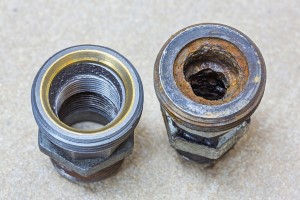November 14, 2018 Barium Sulfate Scale Removal Made EasyFirst, let’s examine why sulfate scales are a problem and how they form: Why Are Sulfate Scales an Issue?In short, sulfate scales cause dramatic and costly oilfield production decline.As a scale deposits around the well-bore, the porous formation media becomes inundated with sulfate scale and is rendered impermeable. In order to remedy the situation, many operations turn to such drastic measures as re-drilling plugged oil wells, replacing down-hole equipment, or even abandoning the operation altogether. How Do Sulfate Scales Form in the Oilfield?During water injection treatments intended to enhance productivity, sulfate scales can form. The following factors lead to this formation:
Why is Barium Sulfate Scale Difficult to Remove?Many scales have high solubility with mineral acids, such as HCl, and/or chelating agents. Sulfate scales, however, have low solubility in both mineral acids and chelating agents. As such, the volume of a standard chelating agent needed to solubilize barium sulfate is too great to be economical. Additionally, traditional acid descaling procedures can corrode components and aren't effective at removing sulfate scales.How To Remove Barium Sulfate ScaleNuGenTec has developed the revolutionary, patent-pending NuFlo® DeScale 433, which quickly removes sulfate scales, including barium sulfate scale, calcium sulfate scale, strontium sulfate scale, and magnesium sulfate scale.NuFlo® DeScale 433 has been proven more effective at dilution than competing solutions have in concentrate, which minimizes downtime for descaling and uses less volume of descaler required for any operation. NuFlo® DeScale 433 has also proven effective in dissolving sulfate scales that are coated and/or interspersed with common organic deposits such as paraffins and asphaltenes. Formulated with a proprietary dissolving chemistry with both polar and nonpolar solubility properties and a synergistic blend of chelating agents, dispersants, and wetting agents, NuFlo® DeScale 433 provides the fastest and most efficient performance of any scale removal solution on the market. NuGenTec: Redefining ChemistryIf you are seeking healthier, more environmentally responsible, and less costly alternatives for your industrial processes, contact NuGenTec today.Click here for more info NuFlo® DeScale 433, including test results on sulfate scales. PRESS RELEASE: NuGenTec’s NuFlo® DeScale 433 is World’s First Product to Dissolve Barium Sulfate Scale in Oil & Gas Pipelines, Flowlines, Formations & Tubulars |
High Performance Specialty Chemicals & Services
Contact Us



